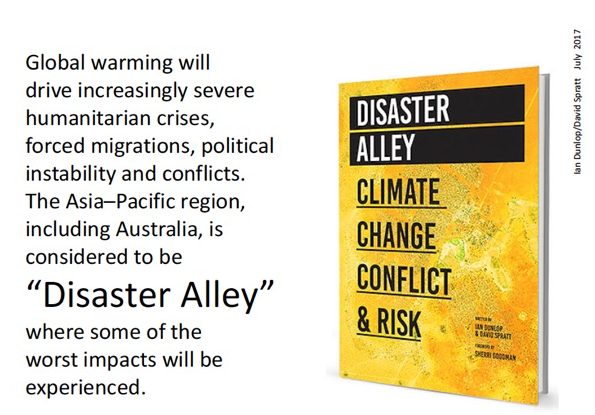Energy policy is the issue to trump them all. We have already lost several Prime Ministers in its cause, and more will likely walk the plank before commonsense prevails. But the last few weeks have set new standards for national stupidity . The political rhetoric grows ever more florid, starting…
Category: Energy

Facing “Disaster Alley”, Australia Shirks Responsibility
The first responsibility of a government is to safeguard the people and their future wellbeing. The ability to do so is increasingly threatened by human-induced climate change, the accelerating impacts of which are driving political instability and conflict globally. Climate change poses an existential risk to humanity which, unless…
The Leaders We Deserve ?
Rarely have politicians demonstrated their ignorance of the real risks and opportunities confronting Australia than with the recent utterances of Barnaby Joyce, Matt Canavan and other ministers promoting development of Adani and Galilee Basin coal generally, along with their petulant foot-stamping over Westpac’s decision to restrict funding to new coal…
Submission to the Review of Climate Change Policies 2017
Contents: Preamble The Key Issue – Existential Risk The Rapidly Changing Context of Global Climate Change Practical Implications The Australian Context Existential Risk Management Reframing Australia’s Climate Change & Energy Policies Author: Ian Dunlop Ian Dunlop has wide experience in energy resources, infrastructure, and international business, for many years…
Submission to the Finkel Review of the National Energy Market
Contents: Preamble The Key Issue – Existential Risk The Rapidly Changing Context of Global Climate Change Practical Implications The Australian Context Existential Risk Management Request to Expert Panel Preamble Thank you for the opportunity to comment on the Preliminary Report into the Future Security of the National Energy Market. …
Energy Security from Clean Coal, CCS & CSG – What could possibly go wrong ?
Every few years the fossil fuel industry pressures politicians to force “clean coal”, carbon capture and storage (CCS) and more recently coal seam gas (CSG) on an increasingly sceptical community to justify their continued expansion. This cycle started with promotion of Adani’s massive Carmichael coal mine in Queensland, for coal…

